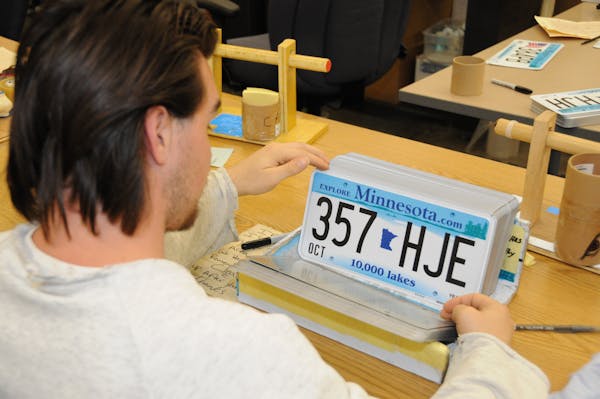How the heck did Minnesota end up with a state muffin?
Listen and subscribe to our podcast: Via Apple Podcasts | Spotify | Stitcher
Hot Dish. Juicy Lucy. Sweet Martha's Cookies. These are some of Minnesota's iconic foods.
Yet none of them have the honor of being codified into state law as symbols of the Land of 10,000 Lakes. Among the foods to claim that status is the humble blueberry muffin, which has been the state muffin since 1988.
Julia Kaiser, a senior at the University of Minnesota, wanted to know the story behind the blueberry muffin's significance and how it became the state muffin. For answers, she turned to Curious Minnesota, the Star Tribune's community-driven series fueled by great reader questions.
Designating an official state muffin is relatively rare. Minnesota is one of only three states to have one — along with New York's apple muffin and Massachusetts' corn muffin. But 36 states have at least one food item among their state symbols, according to State Symbols USA.
The story of Minnesota's muffin begins in 1987 in the city of Carlton, located about 20 miles southwest of Duluth. Carolyn Schroeder's second grade class at South Terrace Elementary School was learning about state symbols. Among the topics was Massachusetts' corn muffin, which had been recently designated at the urging of a local elementary school class.
The class began to brainstorm what muffin they would choose for Minnesota, if given the chance.
"And these are 7- or 8-year-old kids who haven't traveled very much," said Schroeder, now retired and living in Duluth.
So they went with what they knew. While it may not be a crop that people usually associate with Minnesota, the state is one of the top blueberry producers in the country. Northern Minnesota in particular provides a good climate for wild blueberries to thrive.
The original brainstorming session turned into a letter-writing campaign to local elected officials, which caught the attention of Rep. Mary Murphy, DFL-Hermantown.
Murphy herself is the first to admit she is not the world's biggest blueberry enthusiast. But she was impressed by the students' commitment to the environment.
"And I knew that thinking would serve Minnesota well," she said in an interview while taking a break during this year's legislative session.
Murphy told the kids it was too late in the 1987 session to introduce anything new, but promised to help them when the next session rolled around, and she kept her word. In 1988, Murphy sponsored the House bill and helped convince then-Sen. Florian Chmielewski, DFL-Sturgeon Lake, to sponsor the Senate companion bill.
The blueberry was not without its opponents, however.
When the bill to designate the muffin was making its way through the Legislature, the spokesman for the Minnesota Crop Improvement Association asked the assembly what the blueberry had ever done for Minnesota. Minnesota is reflected best by the bran muffin, spokesman Harlan Stoehr argued.
"Our basic premise is that regular folks prefer bran muffins. What do we want, a state of regular folks or a state full of people with blue-stained teeth?" Stoehr said.
But the students — later dubbed the "Blueberry Muffin Gang" — were committed to the blueberry. Throughout the 1988 session, they were invited to the Capitol to watch the bills navigate the legislative process. In one visit, they even handed out blueberry muffins to various lawmakers to drum up support.
Gov. Rudy Perpich signed the bill into law on April 26, 1988. Incidentally, Perpich also inked the bills establishing the state mushroom (the morel), the state grain (wild rice) and the state drink (milk).
Schroeder remembers the fanfare surrounding the muffin bill becoming official. Perpich flew out to the elementary school to reenact the signing of the bill.
"He came to our little gym," she said. "And the kids actually got to sign the real bill. For the longest, longest time it was framed in the front lobby of the school."
For Schroeder, the bill was never really about blueberry muffins. It was about education.
"You can never replace what those kids learned about government, about the legislative process firsthand," she said. "I also think it was the first time these kids were truly heard by adults."
Decades after the bill was signed into law, both Murphy and Schroeder still run into those students — now adults with jobs and kids.
Schroeder also has a constant reminder of the event sitting right outside her window. After the bill was signed into law, a nursery in Grand Rapids gave the class several blueberry plants in honor of their achievement. Schroeder's is still growing strong, 34 years later.
If you'd like to submit a Curious Minnesota question, fill out the form below:
Read more Curious Minnesota stories:
Why is a casserole called hot dish in Minnesota?
Why are Honeycrisp apples still so expensive?
The Jolly Green Giant has moved on from Minnesota. So who is maintaining his iconic billboard?
Is Minnesota really one of the nation's top sugar producers?
Corn dog vs Pronto Pup: Why are people so loyal to one or the other?
Why did Minneapolis' famous flour boom go bust?





